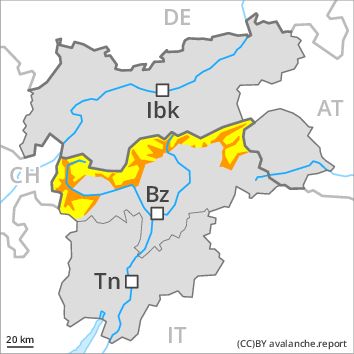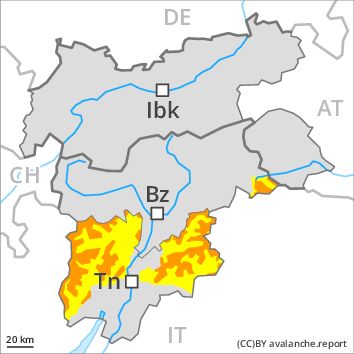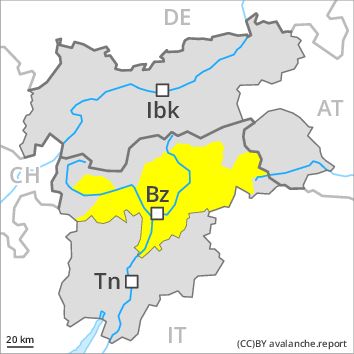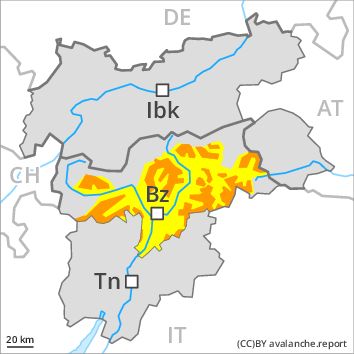Regions
Texel Mountains, Durreck Range, Western Rieserferner Mountains, Val Müstair Alps, Langtaufers, Ortler Range, Schnals Ridge, Southern Stubai Alps, Southern Zillertal Alps and High Tauern
AM

Danger level
Danger Level 2 - Moderate above 2400m
Danger Level 3 - Considerable above 2400m
Avalanche Problem
Wet snow above 2400m, N-NE-E-SE-S-SW-W-NW
Wind-drifted snow above 2400m, N-NE-E-NW
PM

Danger level
Danger Level 3 - Considerable above 2400m
Danger Level 3 - Considerable above 2400m
Avalanche Problem
Wet snow, N-NE-E-SE-S-SW-W-NW
Further increase in danger of wet and gliding avalanches as a consequence of warming.
In all aspects and below approximately 2400 m moist and wet avalanches are possible at any time, even quite large ones. Transportation routes situated at higher altitudes in particular can be endangered occasionally. Gradual increase in danger of wet and gliding avalanches as a consequence of warming during the day and solar radiation. This applies in particular in case of releases originating from starting zones above approximately 2400 m that have retained the snow thus far. The mostly small wind slabs can be released, especially by large additional loads, in particular on northwest to north to east facing aspects above approximately 2400 m.
Snowpack
Outgoing longwave radiation during the night will be quite good over a wide area. The surface of the snowpack has frozen to form a strong crust only at high altitudes and will soften quickly. The more recent wind slabs are clearly recognisable to the trained eye. Backcountry touring calls for caution and restraint. The snowpack will be wet all the way through below approximately 2000 m.
Tendency
As the temperature drops the natural avalanche activity will gradually decrease.
Regions
Sexten Dolomites, Latemar, Southern Adamello, Primiero - Pale di S. Martino, Adamello - Presanella, Northern Brenta - Peller, Western Nonsberg Alps, Southern Brenta, Fassa Valley, Sole, Pejo and Rabbi, Southern Lagorai, Northern Lagorai, Maddalene, Paganella, Pine' - Mocheni Valley
AM

Danger level
Danger Level 2 - Moderate above the treeline
Danger Level 2 - Moderate above the treeline
Avalanche Problem
Wet snow, N-NE-E-SE-S-SW-W-NW
Persistent weak layer above 2200m, N-NE-NW
PM

Danger level
Danger Level 3 - Considerable above the treeline
Danger Level 2 - Moderate above the treeline
Avalanche Problem
Wet snow, N-NE-E-SE-S-SW-W-NW
Persistent weak layer above 2200m, N-NE-NW
The danger of moist and wet avalanches will increase during the day.
Especially on rocky sunny slopes and on wind-loaded slopes numerous medium-sized and, in isolated cases, large natural wet avalanches are possible as a consequence of warming. The danger of wet and gliding avalanches will increase during the day. Weak layers exist in the snowpack in particular on wind-loaded slopes. This applies on steep northeast, north and northwest facing slopes above approximately 2200 m adjacent to ridgelines. These avalanche prone locations are difficult to recognise. The sometimes fresh snow-covered wind slabs are to be evaluated with care and prudence in particular in very steep terrain. In the regions exposed to heavier precipitation the avalanche prone locations are more prevalent and larger. As a consequence of warming, the likelihood of moist and wet avalanches being released will increase gradually in particular on steep slopes at intermediate altitudes.
Snowpack
dp 10: springtime scenario
The older wind slabs have bonded well with the old snowpack. In very isolated cases weak layers exist in the old snowpack on shady slopes, in particular in areas where the snow cover is rather shallow. In some places wind slabs are lying on soft layers, in particular on shady slopes above approximately 2400 m. At low altitude a little snow is lying.
Tendency
Slight decrease in avalanche danger as the snowfall level drops.
Regions
Gröden Dolomites, Prags Dolomites, Sarntal Alps, Western Pfunderer Mountains, Eastern Pfunderer Mountains, Western Deferegger Alps, Ulten Valley, Eastern Nonsberger Alps, Northern Dolomites of Fiemme, Saldurn-Mastaun Ridge
AM

Danger level
Danger Level 2 - Moderate above 1800m
Danger Level 2 - Moderate above 1800m
Avalanche Problem
Wet snow above 2400m, N-NE-E-SE-S-SW-W-NW
Persistent weak layer above 2400m, N-NE-NW
PM

Danger level
Danger Level 3 - Considerable above 1800m
Danger Level 2 - Moderate above 1800m
Avalanche Problem
Wet snow, N-NE-E-SE-S-SW-W-NW
Persistent weak layer above 2400m, N-NE-NW
The danger of moist and wet avalanches will already increase in the early morning.
More frequent medium-sized and, in isolated cases, large moist and wet avalanches are possible in all altitude zones. The danger of wet and gliding avalanches will increase quickly during the day. Weak layers exist in the snowpack. This applies on steep northeast, north and northwest facing slopes above approximately 2400 m. These avalanche prone locations are difficult to recognise. Weak layers in the old snowpack can be released in isolated cases even by individual winter sport participants in particular on steep, little used shady slopes.
Snowpack
Outgoing longwave radiation during the night will be quite good over a wide area. The surface of the snowpack will freeze to form a strong crust only at high altitudes and will soften earlier than the day before. Faceted weak layers exist in the old snowpack on shady slopes, in particular in areas where the snow cover is rather shallow. The older wind slabs have bonded well with the old snowpack.
Tendency
Gradual decrease in danger of wet avalanches as the temperature drops.





